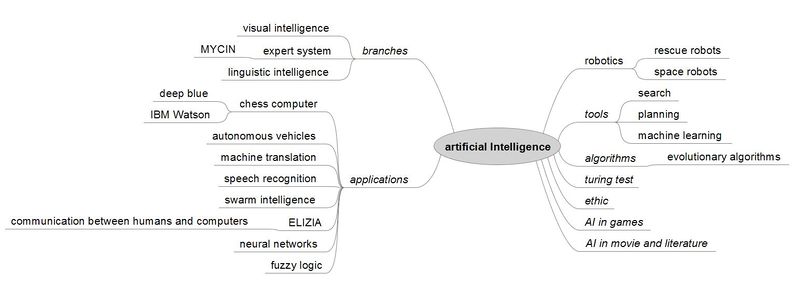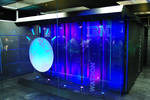No edit summary |
No edit summary |
||
| Line 79: | Line 79: | ||
Autonomous vehicles (driverless car) are vehicles, that are able to navigate, without an human input. They use various sensors (GPS, computer vision)to sense the environment. | Autonomous vehicles (driverless car) are vehicles, that are able to navigate, without an human input. They use various sensors (GPS, computer vision)to sense the environment. | ||
== Examples == | ==== Examples ==== | ||
*[http://de.wikipedia.org/wiki/Google_Driverless_Car Google Driverless Car] | *[http://de.wikipedia.org/wiki/Google_Driverless_Car Google Driverless Car] | ||
**The car using a 360° camera to scan the area | **The car using a 360° camera to scan the area | ||
**It works on the normal streets | **It works on the normal streets | ||
== advantages == | ==== advantages ==== | ||
- Less traffic congestion | - Less traffic congestion | ||
| Line 90: | Line 90: | ||
- (Maybe) less number of accidents | - (Maybe) less number of accidents | ||
== disadvantages == | ==== disadvantages ==== | ||
- Liability for accidents | - Liability for accidents | ||
| Line 114: | Line 114: | ||
=== speech recognition === | === speech recognition === | ||
Speech recognitions means the translation of speech into a text (STT = speec to text). Some systems has to be "trained" to understand the individual speaker. | |||
==== applications ==== | |||
- military | |||
- cars | |||
- multimedia (smart phones, smart tv) | |||
- telephony (hotlines) | |||
Revision as of 23:09, 21 October 2014
Definition
AI stands for "Artificial Intelligence" and means the autonomous acting of machines. This is inalienable in our mordern world but it also brings some disadvantages. Many parts of AI works hand in hand with robotics.
Subjects

Chronology
Past
In the past the humans have done all works manually with their hands. Often it was a hard physical work. With manually controlled machines became the work much easier and healthier.
Present
Today we have still machines who have to be controlled manually by humans but we also have more and more machines who can act autonomous. Some machines with AI just do simple translations by using human created libraries. But today we have also very intelligent AI with the autonoumous self driving prototype of the "Google Driverless Car".
Future
Nobody knows what the future will bring but we see clear trends.
- Self driving cars
- Human robots
- Autonomous military robots and AI software (look also: Military)
- Replacing human's work
Long Term Goals
Philosophy
- Can a machine act intelligently? Can it solve any problem that a person would solve by thinking?
- Are human intelligence and machine intelligence the same? Is the human brain essentially a computer?
- Can a machine have a mind, mental states and consciousness in the same sense humans do? Can it feel how things are?
AI vs mankind
- The beginning of the end for humanity?
tools
search
planning
machine learning
algorithms
evolutionary algorithms
Applications
chess computer
- Deep Blue, a chess-playing computer developed by IBM which beat Garry Kasparov in 1997.
IBM Watson

A pilot service by IBM to uncover and share data-driven insights, and to spur cognitive applications. A question answering system developed by IBM to play the Jeopardy! game show.
Description
Watson is a question answering (QA) computing system that IBM built to apply advanced natural language processing, information retrieval, knowledge representation, automated reasoning, and machine learning technologies to the field of open domain question answering.
Software
Watson uses IBM's DeepQA software and the Apache UIMA (Unstructured Information Management Architecture) framework. The system was written in various languages, including Java, C++, and Prolog, and runs on the SUSE Linux Enterprise Server 11 operating system using Apache Hadoop framework to provide distributed computing.
Hardware
Watson is composed of a cluster of ninety IBM Power 750 servers, each of which uses a 3.5 GHz POWER7 eight core processor, with four threads per core. In total, the system has 2,880 POWER7 processor cores and has 16 terabytes of RAM.
Future Use
autonomous vehicles
Autonomous vehicles (driverless car) are vehicles, that are able to navigate, without an human input. They use various sensors (GPS, computer vision)to sense the environment.
Examples
- Google Driverless Car
- The car using a 360° camera to scan the area
- It works on the normal streets
advantages
- Less traffic congestion - Smooth riding - (Maybe) less number of accidents
disadvantages
- Liability for accidents - Ethical problems: How to react in a potential crash situation - Loss of some jobs
Robotics
Robots with soul
Playful, reactive and courious Robots. First attempts were made by creating robots which can interact by spontaneous making music with humans. Less mechanical structure and more gentle and smooth robotic behaviour allows robots to look more friendly. Focusing the development of robots who either work with humans insted of executing simple instructions robots are accepted as an partner. This can be viewed as a robotic revolution because of its more intuitive and risk taking behaviour.
Guy Hoffman´s research in human-robot interaction deals with teamwork and collaboration between the robot and a human. His Shimon-robot is a try to connect human musicians to a robot by combining their skills, but also by gestures and behaviour.
Obviously robots will become more humanoid in future. Another example is the Data robot, a stand-up comedian which is capable to gahter audience feedback and even reacting to it. Interesting is it´s individual and unexpecetd perfomance.
Modern robot technology is also affected by arts, acting and cultures.
humanoid robot
- A humanoid robot is mostly designed after the appearance of a human. The idea is to create a robot that can act like a human with all his functions. The AI is an significant part to analyse the information the robot receives for example how to manage stairs. A yearly event is the RoboCup wich is an robotics competition with the aim to promote robotics and AI research.
speech recognition
Speech recognitions means the translation of speech into a text (STT = speec to text). Some systems has to be "trained" to understand the individual speaker.
applications
- military - cars - multimedia (smart phones, smart tv) - telephony (hotlines)
machine translation
swarm intelligence
Swarm intelligence (SI) is the collective behavior of decentralized, self-organized systems, natural or artificial. The concept is employed in work on artificial intelligence. The expression was introduced by Gerardo Beni and Jing Wang in 1989, in the context of cellular robotic systems.
fuzzy logic
neural networks
In Science Fiction
Science fiction films and books are full of robots and types of artificial intelligence. Often the questions of morality and consciousness are in focus. Many movies in which a AI plays a role are rather bleak with no hope for mankind or have an bad ending. A selection of important works is listed below.
Books
- I, Robot (Isaac Asimov) A series of short story's about interactions between robots and humans with a morality focus.
- 2001 A Space Odyssey (Arthur C. Clarke)
- The Cyberiad (Stanisław Lem)
Movies and TV
- Jarvis a personal assistant in Iron Man movies
- Star Wars: R2D2 & C-3PO are really good examples
- Star Trek: Data as an Android
- Star Trek: The Borg - Hive
- Terminator Series
- Blade Runner
- WarGames
- Metropolis
- The Matrix trilogy
- WALL-E
- Real Humans - Hubots
- Alien Saga: Android Bishop
Video Games
- System Shock Series
- Mass Effect
In Video Games
In video games, artificial intelligence is used to generate intelligent behaviors primarily in non-player characters (NPCs), often simulating human-like intelligence.
Or as an other species like the Geth http://masseffect.wikia.com/wiki/Geth in Mass Effect
History
Games with excellent AI
- Black and White
- Creatures
- SimCity
- F.E.A.R.
- Crysis
- Half-Life 1&2
- Halo
- Civilization
Ethics of artificial intelligence
The ethics of artificial intelligence is the part of the ethics of technology specific to robots and other artificially intelligent beings. It is typically divided into roboethics, a concern with the moral behavior of humans as they design, construct, use and treat artificially intelligent beings, and machine ethics, concern with the moral behavior of artificial moral agents (AMAs).
People
Alan Turing
Alan Mathison Turing, (23 June 1912 – 7 June 1954) is considered the father of theoretical computer science and artificial intelligence. He provided a test for "intelligent" machines which tests if the response of a machine is indistinguishable from the response of a human.
Advantages and disadvantages
Advantages
- Work can be much faster
- Products have a consistent quality
- Intelligent machines do hard work instead of humans.
- People are more healthy
- Dangerous work can be done more effectively.
Disadvantages
- Because machines can do more and faster human works many people lose their jobs and complete industries are nearly controlled by robots and AI systems.
- AI systems can be just as perfect as the human who creates it.
- Can only make rational decisions.
- Lack of interpersonal skills.